Audit and Assurance Assignment: DIPL Ltd. Analysis and Audit
VerifiedAdded on 2020/03/04
|9
|2061
|48
Homework Assignment
AI Summary
This assignment analyzes the audit and assurance practices applied to DIPL Ltd., focusing on analytical procedures, risk assessment, and potential frauds. The solution begins by outlining various analytical procedures, such as comparing current and previous financial data, industry benchmarks, and projected figures to identify trends and variances. It emphasizes the importance of verifying balance confirmations and calculating financial ratios to assess the company's performance. The assignment then explores inherent risks, including the implications of a new IT system implementation and the appointment of a CEO with financial interests, potentially leading to biased financial reporting. Furthermore, the solution identifies potential fraudulent activities related to unrecorded entries and inflated inventory values, discussing their impact on the auditor's opinion and the misrepresentation of financial statements. The assignment underscores the auditor's responsibility to maintain an unbiased perspective and assess all aspects of the business thoroughly to provide a fair and accurate opinion.
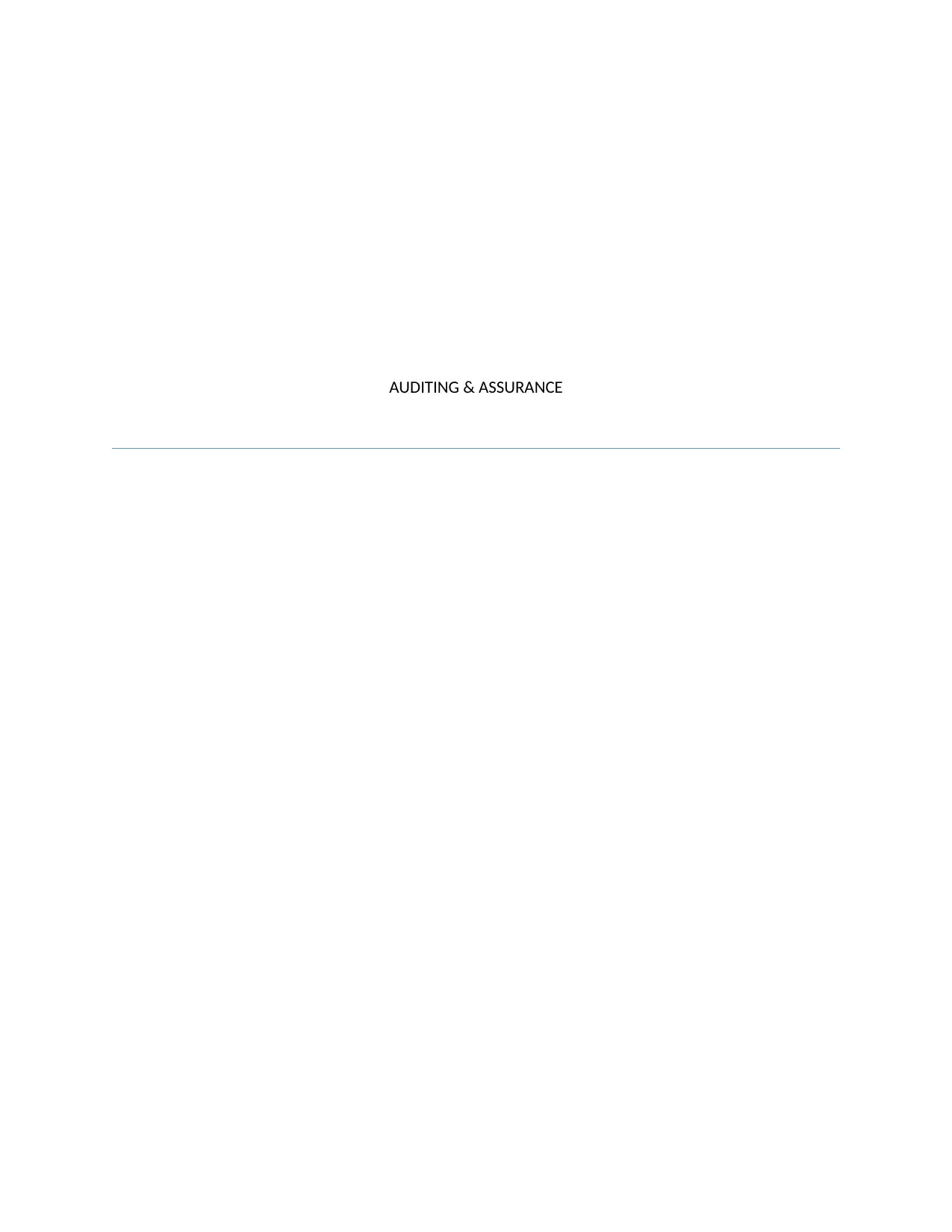
AUDITING & ASSURANCE
Paraphrase This Document
Need a fresh take? Get an instant paraphrase of this document with our AI Paraphraser
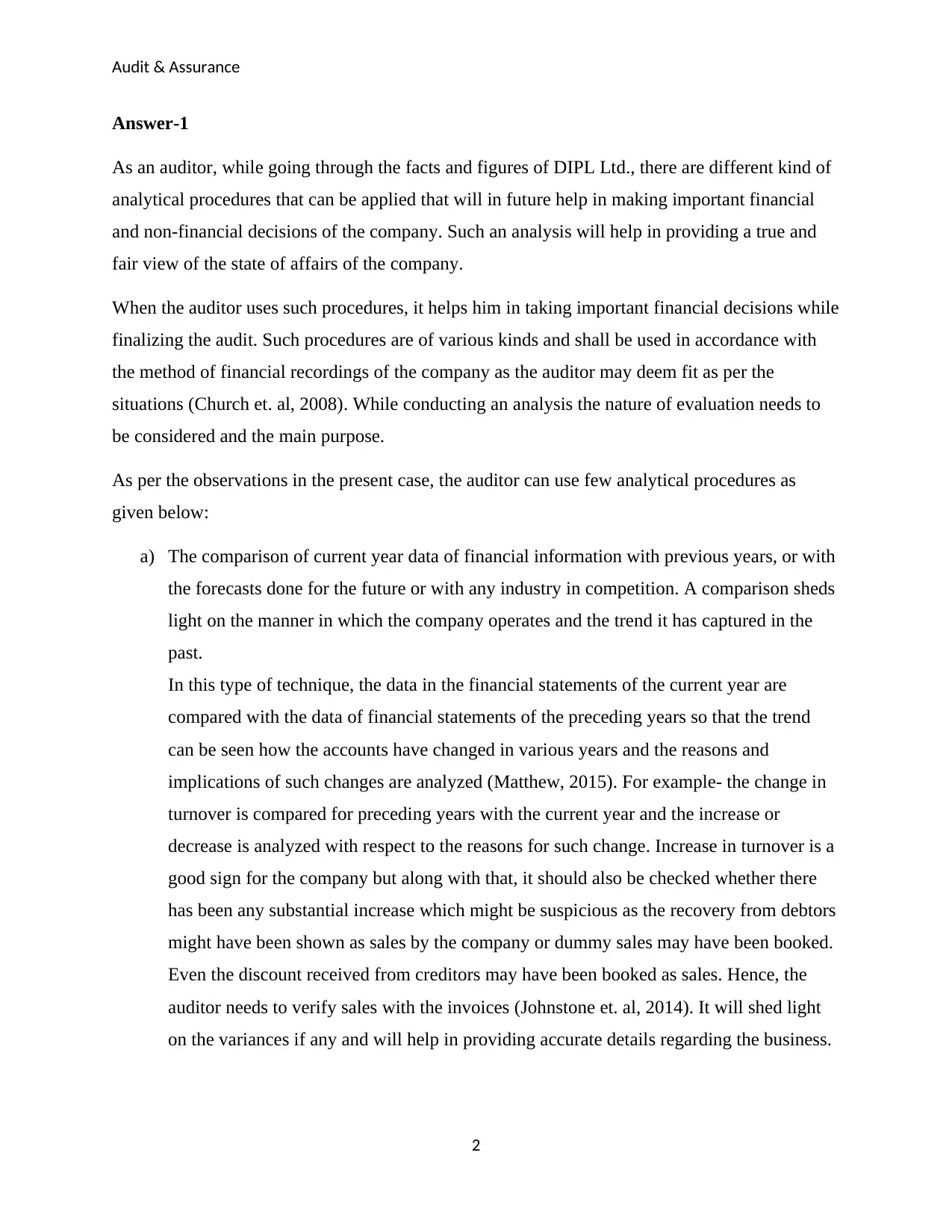
Audit & Assurance
Answer-1
As an auditor, while going through the facts and figures of DIPL Ltd., there are different kind of
analytical procedures that can be applied that will in future help in making important financial
and non-financial decisions of the company. Such an analysis will help in providing a true and
fair view of the state of affairs of the company.
When the auditor uses such procedures, it helps him in taking important financial decisions while
finalizing the audit. Such procedures are of various kinds and shall be used in accordance with
the method of financial recordings of the company as the auditor may deem fit as per the
situations (Church et. al, 2008). While conducting an analysis the nature of evaluation needs to
be considered and the main purpose.
As per the observations in the present case, the auditor can use few analytical procedures as
given below:
a) The comparison of current year data of financial information with previous years, or with
the forecasts done for the future or with any industry in competition. A comparison sheds
light on the manner in which the company operates and the trend it has captured in the
past.
In this type of technique, the data in the financial statements of the current year are
compared with the data of financial statements of the preceding years so that the trend
can be seen how the accounts have changed in various years and the reasons and
implications of such changes are analyzed (Matthew, 2015). For example- the change in
turnover is compared for preceding years with the current year and the increase or
decrease is analyzed with respect to the reasons for such change. Increase in turnover is a
good sign for the company but along with that, it should also be checked whether there
has been any substantial increase which might be suspicious as the recovery from debtors
might have been shown as sales by the company or dummy sales may have been booked.
Even the discount received from creditors may have been booked as sales. Hence, the
auditor needs to verify sales with the invoices (Johnstone et. al, 2014). It will shed light
on the variances if any and will help in providing accurate details regarding the business.
2
Answer-1
As an auditor, while going through the facts and figures of DIPL Ltd., there are different kind of
analytical procedures that can be applied that will in future help in making important financial
and non-financial decisions of the company. Such an analysis will help in providing a true and
fair view of the state of affairs of the company.
When the auditor uses such procedures, it helps him in taking important financial decisions while
finalizing the audit. Such procedures are of various kinds and shall be used in accordance with
the method of financial recordings of the company as the auditor may deem fit as per the
situations (Church et. al, 2008). While conducting an analysis the nature of evaluation needs to
be considered and the main purpose.
As per the observations in the present case, the auditor can use few analytical procedures as
given below:
a) The comparison of current year data of financial information with previous years, or with
the forecasts done for the future or with any industry in competition. A comparison sheds
light on the manner in which the company operates and the trend it has captured in the
past.
In this type of technique, the data in the financial statements of the current year are
compared with the data of financial statements of the preceding years so that the trend
can be seen how the accounts have changed in various years and the reasons and
implications of such changes are analyzed (Matthew, 2015). For example- the change in
turnover is compared for preceding years with the current year and the increase or
decrease is analyzed with respect to the reasons for such change. Increase in turnover is a
good sign for the company but along with that, it should also be checked whether there
has been any substantial increase which might be suspicious as the recovery from debtors
might have been shown as sales by the company or dummy sales may have been booked.
Even the discount received from creditors may have been booked as sales. Hence, the
auditor needs to verify sales with the invoices (Johnstone et. al, 2014). It will shed light
on the variances if any and will help in providing accurate details regarding the business.
2

Audit & Assurance
Further, the comparison can be done with the competing companies in the industry so
that it can be seen that whether there are any such accounts where there can be any
management problems that need to be settled down.
Apart from this, the comparison shall be done with the figures that were projected in the
previous years for the current year so that deviations can be calculated and the reasons for
the same shall also be known (Geoffrey et. al, 2016).
b) Balance confirmation of Debtors and Creditors and random checking of balances written
off should be thoroughly checked because there exists the possibility that the balance
may be collected or settled and the company does not have any information regarding
this. The same recovery can be shown as sales for the corresponding period (Riddle,
2015). Hence, the auditor should check these points through confirmation statements.
c) Ratios can be calculated showing relationship of one item of accounts to another. Few
examples are- Gross Profit to Sales, Net Profit to Sales, Inventory to Sales, Current Ratio,
Quick Ratio, Liquidity Ratio. Such ratios help in analyzing the trends of changes in these
elements with a change in sales.
If we calculate these ratios for 3 years under preview, we can see that the ratios are
almost consistent in the given three years. Such as-
i. Net Profit Ratio= Net Profit after Tax / Sales *100
2013= 23, 59,190/ 3, 42, 12,000 *100 = 6.90
2014= 22, 91,362/ 3, 76, 99,500 *100 = 6.08
2015= 29, 72,183/ 4, 34, 59,500 * 100 = 6.84
ii. Gross Profit Ratio = Gross Profit / Sales *100
2013 = 17.55%
2014 = 16.14%
2015 = 15.199%
All other ratios are also to be considered. Other ratios such as solvency ratio and liquidity ratio
will shed on another aspect. It is important for the auditor to ascertain whether the business is
3
Further, the comparison can be done with the competing companies in the industry so
that it can be seen that whether there are any such accounts where there can be any
management problems that need to be settled down.
Apart from this, the comparison shall be done with the figures that were projected in the
previous years for the current year so that deviations can be calculated and the reasons for
the same shall also be known (Geoffrey et. al, 2016).
b) Balance confirmation of Debtors and Creditors and random checking of balances written
off should be thoroughly checked because there exists the possibility that the balance
may be collected or settled and the company does not have any information regarding
this. The same recovery can be shown as sales for the corresponding period (Riddle,
2015). Hence, the auditor should check these points through confirmation statements.
c) Ratios can be calculated showing relationship of one item of accounts to another. Few
examples are- Gross Profit to Sales, Net Profit to Sales, Inventory to Sales, Current Ratio,
Quick Ratio, Liquidity Ratio. Such ratios help in analyzing the trends of changes in these
elements with a change in sales.
If we calculate these ratios for 3 years under preview, we can see that the ratios are
almost consistent in the given three years. Such as-
i. Net Profit Ratio= Net Profit after Tax / Sales *100
2013= 23, 59,190/ 3, 42, 12,000 *100 = 6.90
2014= 22, 91,362/ 3, 76, 99,500 *100 = 6.08
2015= 29, 72,183/ 4, 34, 59,500 * 100 = 6.84
ii. Gross Profit Ratio = Gross Profit / Sales *100
2013 = 17.55%
2014 = 16.14%
2015 = 15.199%
All other ratios are also to be considered. Other ratios such as solvency ratio and liquidity ratio
will shed on another aspect. It is important for the auditor to ascertain whether the business is
3
⊘ This is a preview!⊘
Do you want full access?
Subscribe today to unlock all pages.

Trusted by 1+ million students worldwide

Audit & Assurance
having adequate liquidity and hence, the current and quick ratio can be used. For the solvency
part, the auditor can compute debt ratio and debt-equity ratio to ascertain the solvency position
of the business. If the ratios are consistent then also the auditor needs to view all this diligently
so that if window dressing has been done in accounts to show profitability on a consistent level
then it can be checked and reported (Knapp, 2013). Hence, the auditor needs to apply skills and
knowledge to assess the business position.
4
having adequate liquidity and hence, the current and quick ratio can be used. For the solvency
part, the auditor can compute debt ratio and debt-equity ratio to ascertain the solvency position
of the business. If the ratios are consistent then also the auditor needs to view all this diligently
so that if window dressing has been done in accounts to show profitability on a consistent level
then it can be checked and reported (Knapp, 2013). Hence, the auditor needs to apply skills and
knowledge to assess the business position.
4
Paraphrase This Document
Need a fresh take? Get an instant paraphrase of this document with our AI Paraphraser
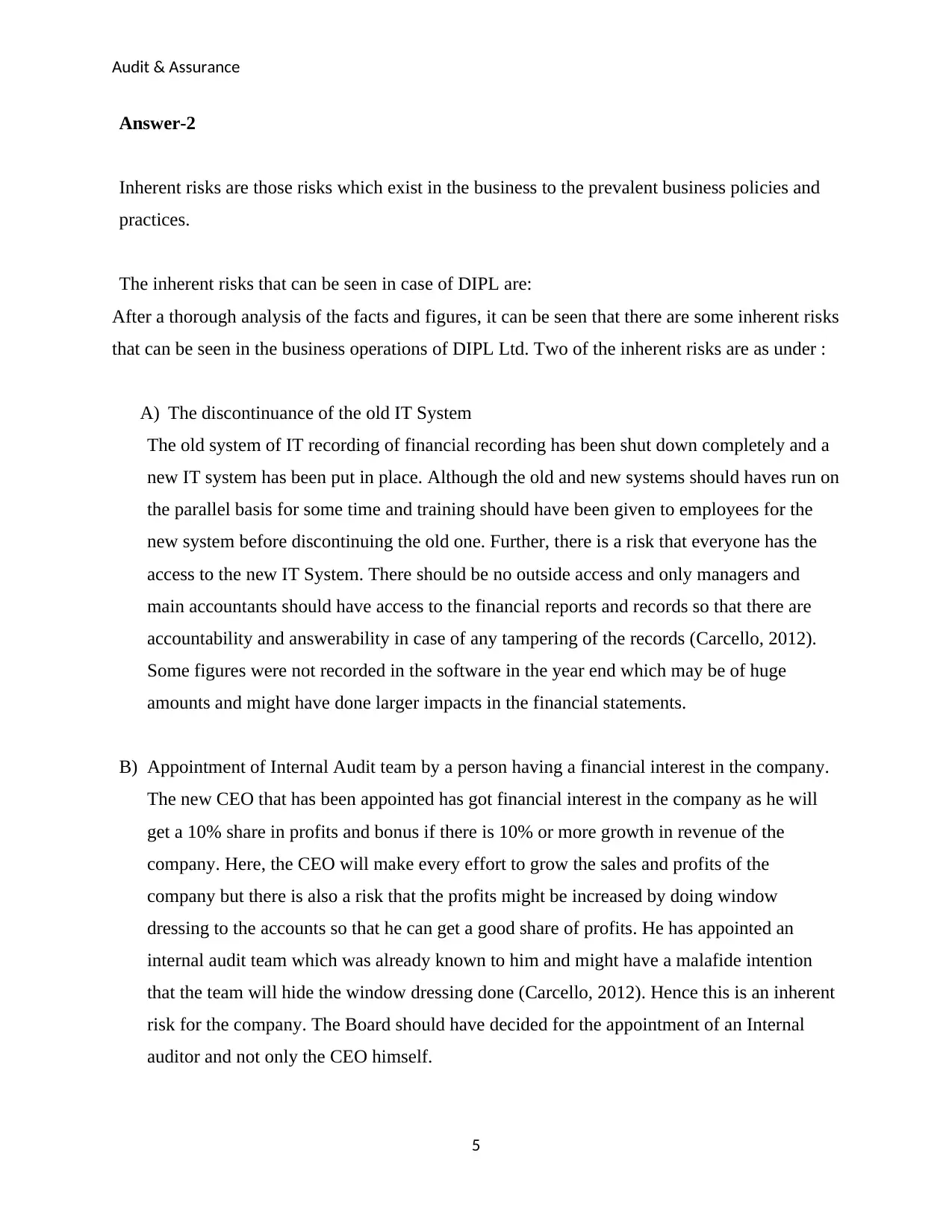
Audit & Assurance
Answer-2
Inherent risks are those risks which exist in the business to the prevalent business policies and
practices.
The inherent risks that can be seen in case of DIPL are:
After a thorough analysis of the facts and figures, it can be seen that there are some inherent risks
that can be seen in the business operations of DIPL Ltd. Two of the inherent risks are as under :
A) The discontinuance of the old IT System
The old system of IT recording of financial recording has been shut down completely and a
new IT system has been put in place. Although the old and new systems should haves run on
the parallel basis for some time and training should have been given to employees for the
new system before discontinuing the old one. Further, there is a risk that everyone has the
access to the new IT System. There should be no outside access and only managers and
main accountants should have access to the financial reports and records so that there are
accountability and answerability in case of any tampering of the records (Carcello, 2012).
Some figures were not recorded in the software in the year end which may be of huge
amounts and might have done larger impacts in the financial statements.
B) Appointment of Internal Audit team by a person having a financial interest in the company.
The new CEO that has been appointed has got financial interest in the company as he will
get a 10% share in profits and bonus if there is 10% or more growth in revenue of the
company. Here, the CEO will make every effort to grow the sales and profits of the
company but there is also a risk that the profits might be increased by doing window
dressing to the accounts so that he can get a good share of profits. He has appointed an
internal audit team which was already known to him and might have a malafide intention
that the team will hide the window dressing done (Carcello, 2012). Hence this is an inherent
risk for the company. The Board should have decided for the appointment of an Internal
auditor and not only the CEO himself.
5
Answer-2
Inherent risks are those risks which exist in the business to the prevalent business policies and
practices.
The inherent risks that can be seen in case of DIPL are:
After a thorough analysis of the facts and figures, it can be seen that there are some inherent risks
that can be seen in the business operations of DIPL Ltd. Two of the inherent risks are as under :
A) The discontinuance of the old IT System
The old system of IT recording of financial recording has been shut down completely and a
new IT system has been put in place. Although the old and new systems should haves run on
the parallel basis for some time and training should have been given to employees for the
new system before discontinuing the old one. Further, there is a risk that everyone has the
access to the new IT System. There should be no outside access and only managers and
main accountants should have access to the financial reports and records so that there are
accountability and answerability in case of any tampering of the records (Carcello, 2012).
Some figures were not recorded in the software in the year end which may be of huge
amounts and might have done larger impacts in the financial statements.
B) Appointment of Internal Audit team by a person having a financial interest in the company.
The new CEO that has been appointed has got financial interest in the company as he will
get a 10% share in profits and bonus if there is 10% or more growth in revenue of the
company. Here, the CEO will make every effort to grow the sales and profits of the
company but there is also a risk that the profits might be increased by doing window
dressing to the accounts so that he can get a good share of profits. He has appointed an
internal audit team which was already known to him and might have a malafide intention
that the team will hide the window dressing done (Carcello, 2012). Hence this is an inherent
risk for the company. The Board should have decided for the appointment of an Internal
auditor and not only the CEO himself.
5
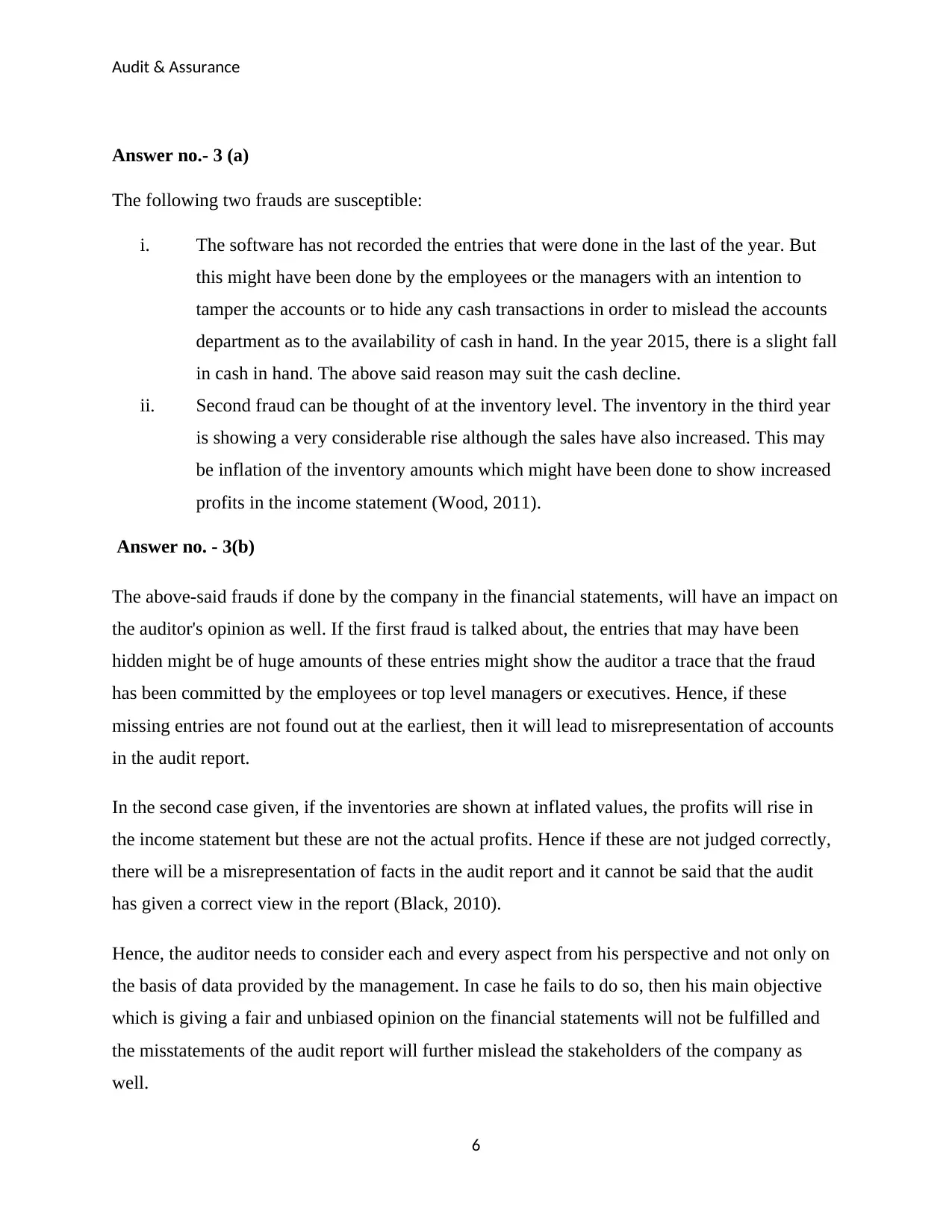
Audit & Assurance
Answer no.- 3 (a)
The following two frauds are susceptible:
i. The software has not recorded the entries that were done in the last of the year. But
this might have been done by the employees or the managers with an intention to
tamper the accounts or to hide any cash transactions in order to mislead the accounts
department as to the availability of cash in hand. In the year 2015, there is a slight fall
in cash in hand. The above said reason may suit the cash decline.
ii. Second fraud can be thought of at the inventory level. The inventory in the third year
is showing a very considerable rise although the sales have also increased. This may
be inflation of the inventory amounts which might have been done to show increased
profits in the income statement (Wood, 2011).
Answer no. - 3(b)
The above-said frauds if done by the company in the financial statements, will have an impact on
the auditor's opinion as well. If the first fraud is talked about, the entries that may have been
hidden might be of huge amounts of these entries might show the auditor a trace that the fraud
has been committed by the employees or top level managers or executives. Hence, if these
missing entries are not found out at the earliest, then it will lead to misrepresentation of accounts
in the audit report.
In the second case given, if the inventories are shown at inflated values, the profits will rise in
the income statement but these are not the actual profits. Hence if these are not judged correctly,
there will be a misrepresentation of facts in the audit report and it cannot be said that the audit
has given a correct view in the report (Black, 2010).
Hence, the auditor needs to consider each and every aspect from his perspective and not only on
the basis of data provided by the management. In case he fails to do so, then his main objective
which is giving a fair and unbiased opinion on the financial statements will not be fulfilled and
the misstatements of the audit report will further mislead the stakeholders of the company as
well.
6
Answer no.- 3 (a)
The following two frauds are susceptible:
i. The software has not recorded the entries that were done in the last of the year. But
this might have been done by the employees or the managers with an intention to
tamper the accounts or to hide any cash transactions in order to mislead the accounts
department as to the availability of cash in hand. In the year 2015, there is a slight fall
in cash in hand. The above said reason may suit the cash decline.
ii. Second fraud can be thought of at the inventory level. The inventory in the third year
is showing a very considerable rise although the sales have also increased. This may
be inflation of the inventory amounts which might have been done to show increased
profits in the income statement (Wood, 2011).
Answer no. - 3(b)
The above-said frauds if done by the company in the financial statements, will have an impact on
the auditor's opinion as well. If the first fraud is talked about, the entries that may have been
hidden might be of huge amounts of these entries might show the auditor a trace that the fraud
has been committed by the employees or top level managers or executives. Hence, if these
missing entries are not found out at the earliest, then it will lead to misrepresentation of accounts
in the audit report.
In the second case given, if the inventories are shown at inflated values, the profits will rise in
the income statement but these are not the actual profits. Hence if these are not judged correctly,
there will be a misrepresentation of facts in the audit report and it cannot be said that the audit
has given a correct view in the report (Black, 2010).
Hence, the auditor needs to consider each and every aspect from his perspective and not only on
the basis of data provided by the management. In case he fails to do so, then his main objective
which is giving a fair and unbiased opinion on the financial statements will not be fulfilled and
the misstatements of the audit report will further mislead the stakeholders of the company as
well.
6
⊘ This is a preview!⊘
Do you want full access?
Subscribe today to unlock all pages.

Trusted by 1+ million students worldwide
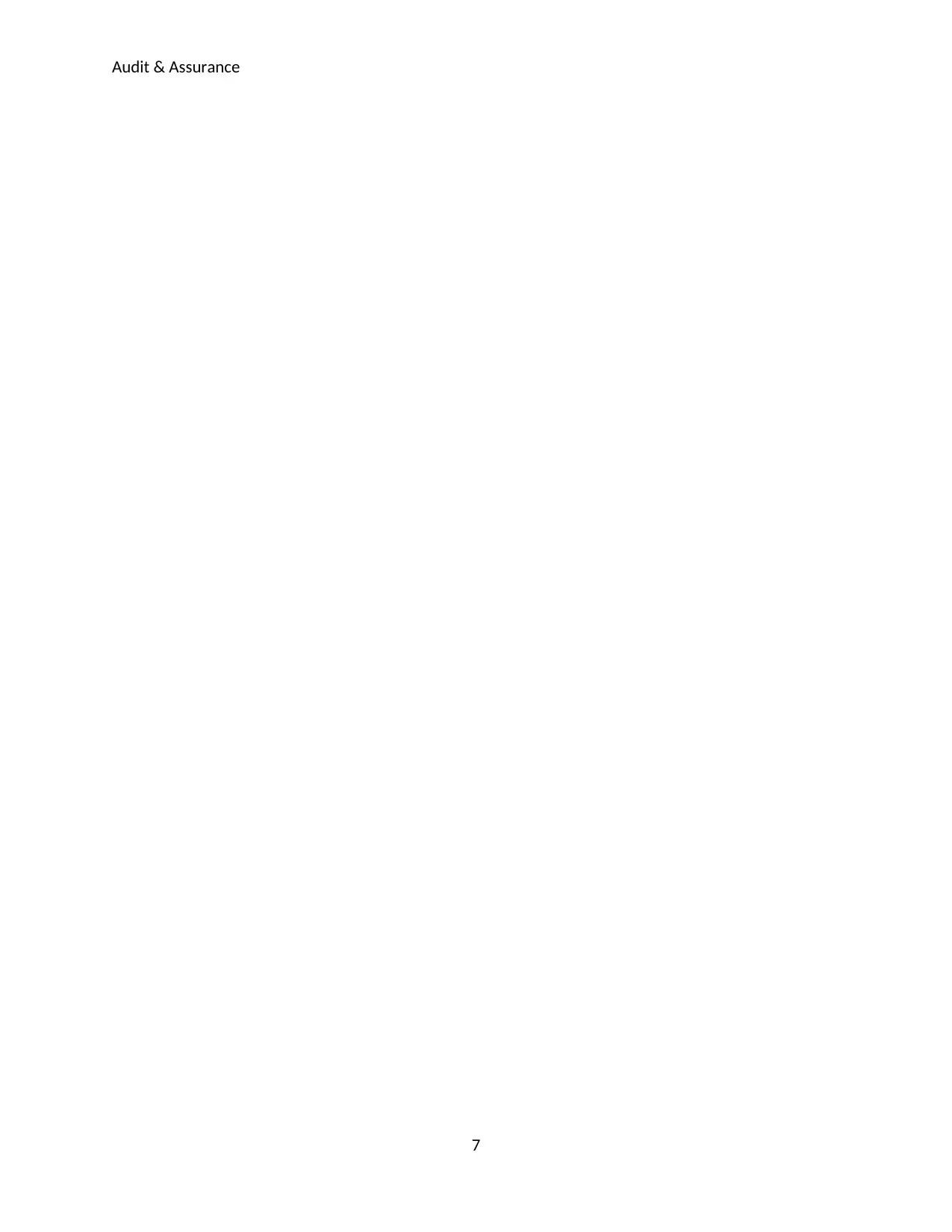
Audit & Assurance
7
7
Paraphrase This Document
Need a fresh take? Get an instant paraphrase of this document with our AI Paraphraser
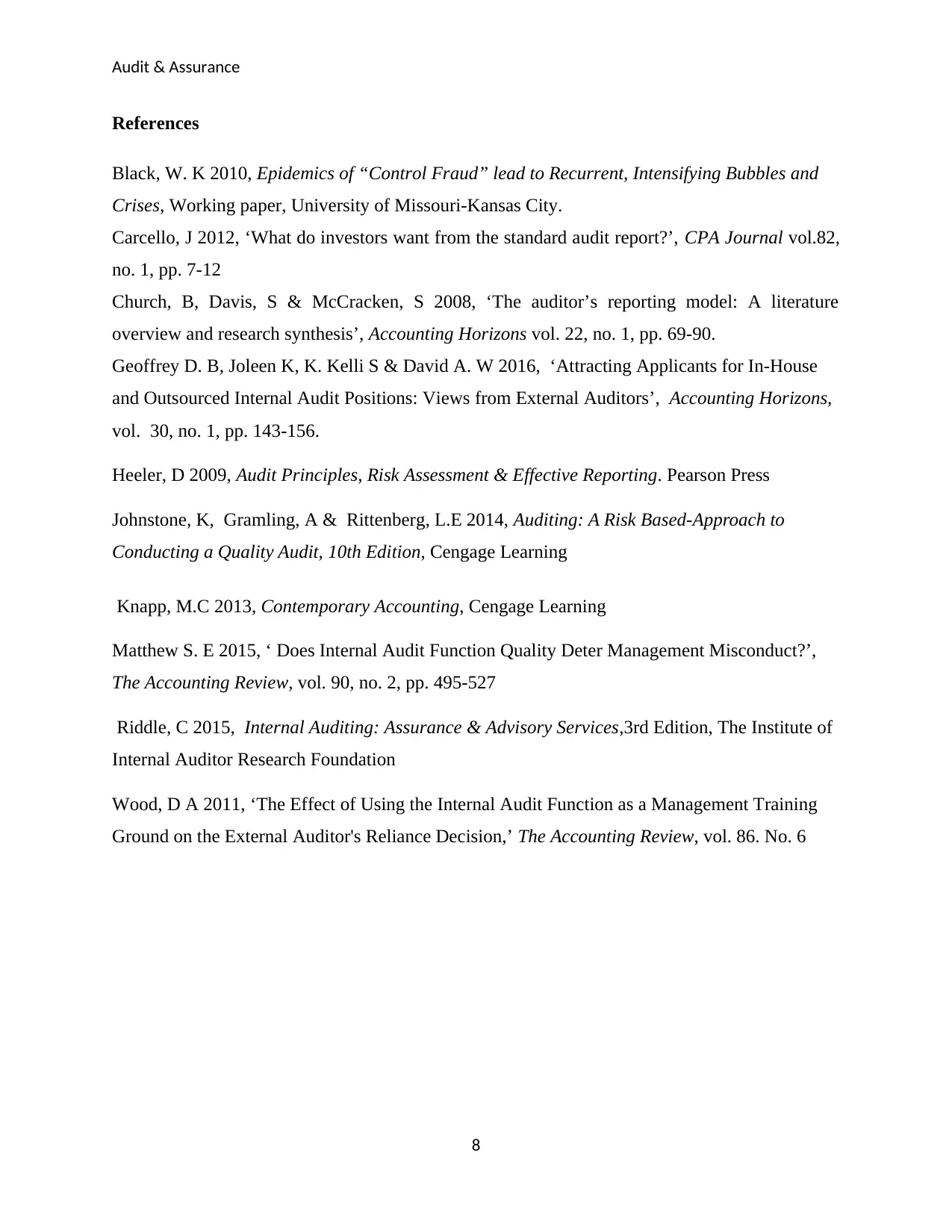
Audit & Assurance
References
Black, W. K 2010, Epidemics of “Control Fraud” lead to Recurrent, Intensifying Bubbles and
Crises, Working paper, University of Missouri-Kansas City.
Carcello, J 2012, ‘What do investors want from the standard audit report?’, CPA Journal vol.82,
no. 1, pp. 7-12
Church, B, Davis, S & McCracken, S 2008, ‘The auditor’s reporting model: A literature
overview and research synthesis’, Accounting Horizons vol. 22, no. 1, pp. 69-90.
Geoffrey D. B, Joleen K, K. Kelli S & David A. W 2016, ‘Attracting Applicants for In-House
and Outsourced Internal Audit Positions: Views from External Auditors’, Accounting Horizons,
vol. 30, no. 1, pp. 143-156.
Heeler, D 2009, Audit Principles, Risk Assessment & Effective Reporting. Pearson Press
Johnstone, K, Gramling, A & Rittenberg, L.E 2014, Auditing: A Risk Based-Approach to
Conducting a Quality Audit, 10th Edition, Cengage Learning
Knapp, M.C 2013, Contemporary Accounting, Cengage Learning
Matthew S. E 2015, ‘ Does Internal Audit Function Quality Deter Management Misconduct?’,
The Accounting Review, vol. 90, no. 2, pp. 495-527
Riddle, C 2015, Internal Auditing: Assurance & Advisory Services,3rd Edition, The Institute of
Internal Auditor Research Foundation
Wood, D A 2011, ‘The Effect of Using the Internal Audit Function as a Management Training
Ground on the External Auditor's Reliance Decision,’ The Accounting Review, vol. 86. No. 6
8
References
Black, W. K 2010, Epidemics of “Control Fraud” lead to Recurrent, Intensifying Bubbles and
Crises, Working paper, University of Missouri-Kansas City.
Carcello, J 2012, ‘What do investors want from the standard audit report?’, CPA Journal vol.82,
no. 1, pp. 7-12
Church, B, Davis, S & McCracken, S 2008, ‘The auditor’s reporting model: A literature
overview and research synthesis’, Accounting Horizons vol. 22, no. 1, pp. 69-90.
Geoffrey D. B, Joleen K, K. Kelli S & David A. W 2016, ‘Attracting Applicants for In-House
and Outsourced Internal Audit Positions: Views from External Auditors’, Accounting Horizons,
vol. 30, no. 1, pp. 143-156.
Heeler, D 2009, Audit Principles, Risk Assessment & Effective Reporting. Pearson Press
Johnstone, K, Gramling, A & Rittenberg, L.E 2014, Auditing: A Risk Based-Approach to
Conducting a Quality Audit, 10th Edition, Cengage Learning
Knapp, M.C 2013, Contemporary Accounting, Cengage Learning
Matthew S. E 2015, ‘ Does Internal Audit Function Quality Deter Management Misconduct?’,
The Accounting Review, vol. 90, no. 2, pp. 495-527
Riddle, C 2015, Internal Auditing: Assurance & Advisory Services,3rd Edition, The Institute of
Internal Auditor Research Foundation
Wood, D A 2011, ‘The Effect of Using the Internal Audit Function as a Management Training
Ground on the External Auditor's Reliance Decision,’ The Accounting Review, vol. 86. No. 6
8
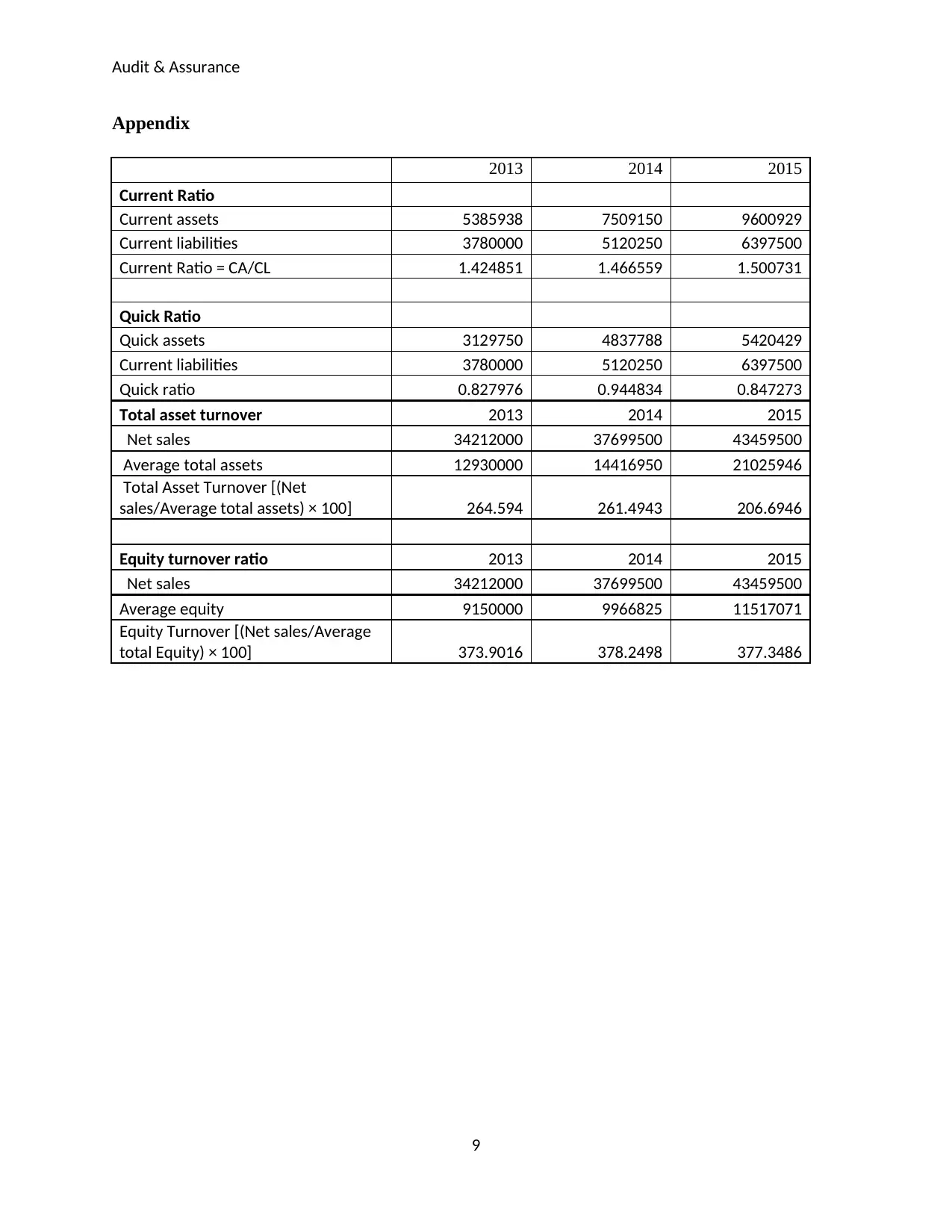
Audit & Assurance
Appendix
2013 2014 2015
Current Ratio
Current assets 5385938 7509150 9600929
Current liabilities 3780000 5120250 6397500
Current Ratio = CA/CL 1.424851 1.466559 1.500731
Quick Ratio
Quick assets 3129750 4837788 5420429
Current liabilities 3780000 5120250 6397500
Quick ratio 0.827976 0.944834 0.847273
Total asset turnover 2013 2014 2015
Net sales 34212000 37699500 43459500
Average total assets 12930000 14416950 21025946
Total Asset Turnover [(Net
sales/Average total assets) × 100] 264.594 261.4943 206.6946
Equity turnover ratio 2013 2014 2015
Net sales 34212000 37699500 43459500
Average equity 9150000 9966825 11517071
Equity Turnover [(Net sales/Average
total Equity) × 100] 373.9016 378.2498 377.3486
9
Appendix
2013 2014 2015
Current Ratio
Current assets 5385938 7509150 9600929
Current liabilities 3780000 5120250 6397500
Current Ratio = CA/CL 1.424851 1.466559 1.500731
Quick Ratio
Quick assets 3129750 4837788 5420429
Current liabilities 3780000 5120250 6397500
Quick ratio 0.827976 0.944834 0.847273
Total asset turnover 2013 2014 2015
Net sales 34212000 37699500 43459500
Average total assets 12930000 14416950 21025946
Total Asset Turnover [(Net
sales/Average total assets) × 100] 264.594 261.4943 206.6946
Equity turnover ratio 2013 2014 2015
Net sales 34212000 37699500 43459500
Average equity 9150000 9966825 11517071
Equity Turnover [(Net sales/Average
total Equity) × 100] 373.9016 378.2498 377.3486
9
⊘ This is a preview!⊘
Do you want full access?
Subscribe today to unlock all pages.

Trusted by 1+ million students worldwide
1 out of 9
Related Documents
Your All-in-One AI-Powered Toolkit for Academic Success.
+13062052269
info@desklib.com
Available 24*7 on WhatsApp / Email
![[object Object]](/_next/static/media/star-bottom.7253800d.svg)
Unlock your academic potential
Copyright © 2020–2025 A2Z Services. All Rights Reserved. Developed and managed by ZUCOL.





